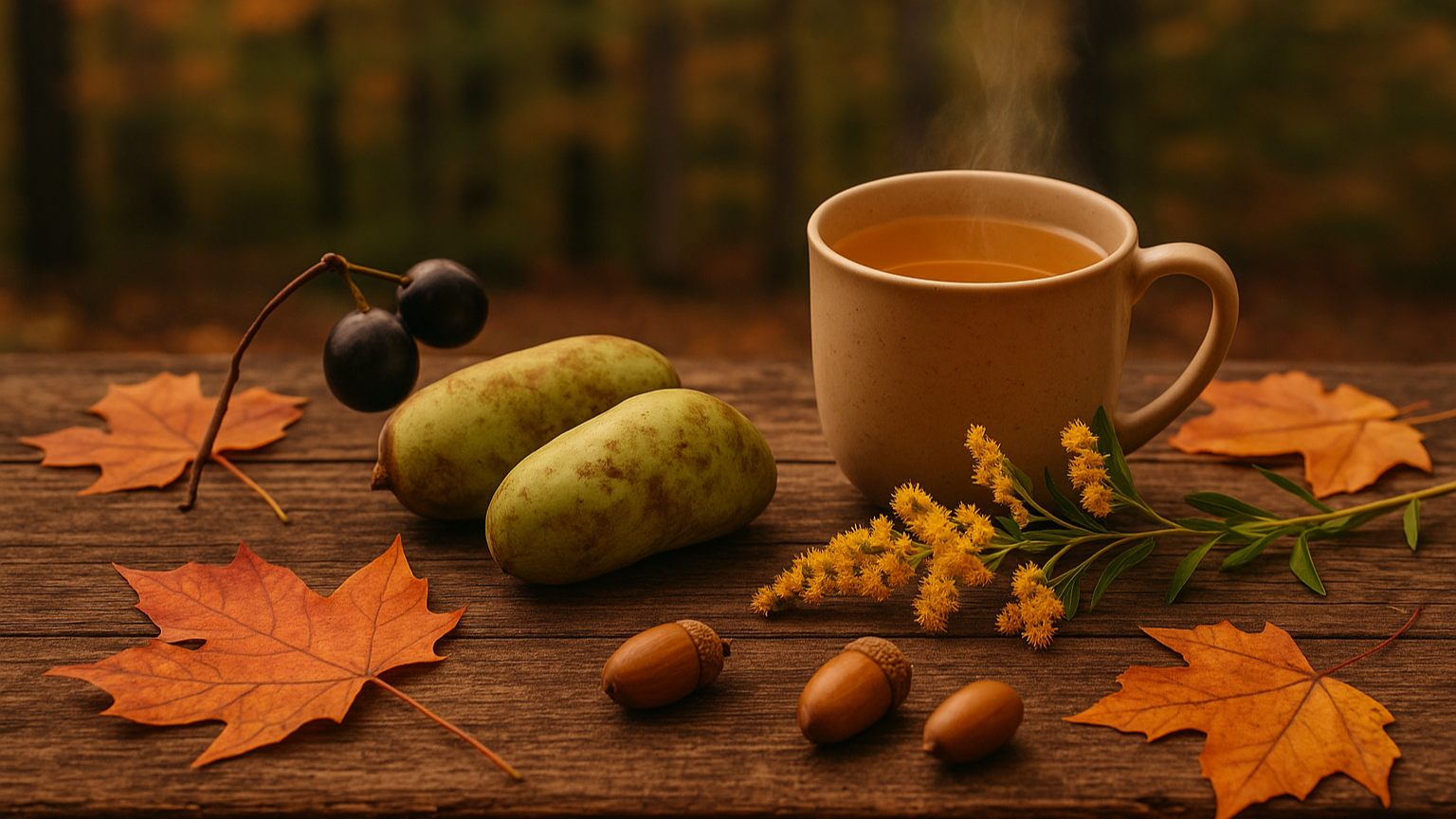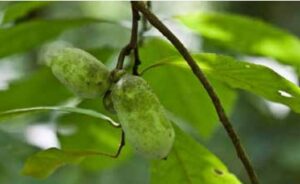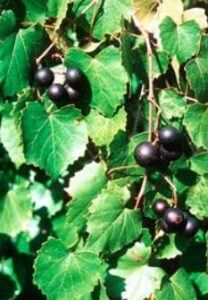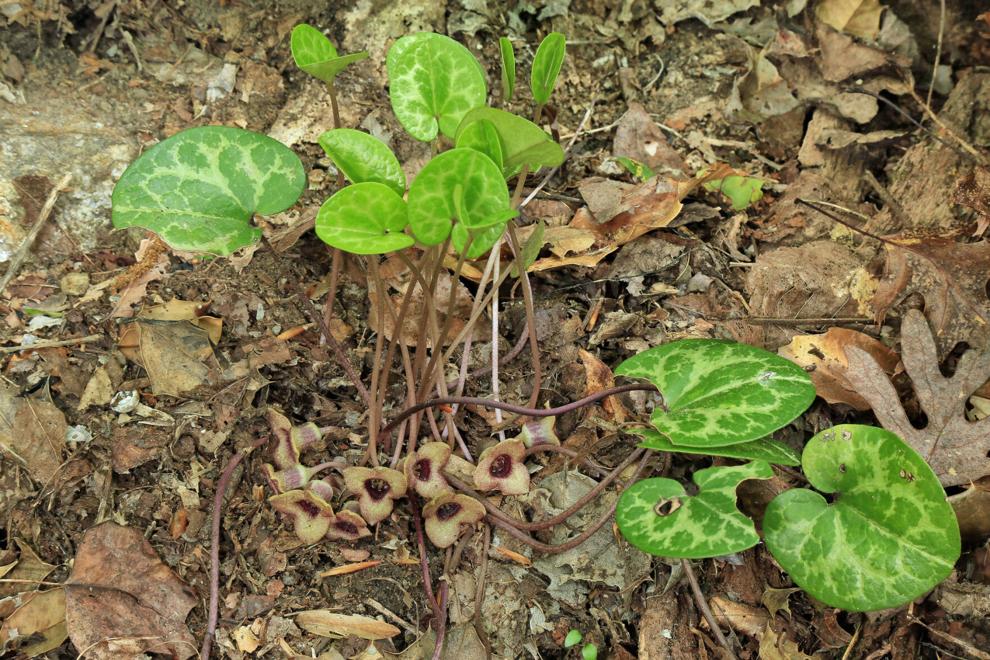Editor’s Note: This article was originally featured in the October 2016 issue of The Journal of the South Carolina Native Plant Society, written by Dan Whitten. We’re delighted to reprint it here with appreciation for Dan’s contributions and his enduring passion for connecting people to the natural world.
⚠️ As with all wild edibles, please use caution: always confirm identification with a reliable guide or expert, avoid contaminated areas, and be aware that even edible species can cause sensitivities in some individuals. The information below is shared for educational purposes only.
For readers inspired to bring these flavors to their own tables, a collection of recipes adapted from Dan’s descriptions appears at the end of this article.
Recipes from the Wild
Explore the flavors featured in Dan Whitten’s “Fall Foods From Nature.”
- Pawpaw Smoothie or Ice Cream
- Muscadine Jelly or Grape Drink
- Sumac Tea (Sumac-Ade)
- Goldenrod Tea
- Acorn Flour Pancakes
- Hen of the Woods Sauté
by Dan Whitten
The harvest season is upon us. The natural thing to do is fatten up for winter. Well, at least we can sample some of nature’s treats that have to be good for us since they taste so good. Here are some of my favorites.
The end of summer favorite is the Pawpaw (Asimina triloba) or custard apple as it was once called (Fig. 1). They ripen near the end of August to early September. You need to eat these up fast or process them for later as they are very perishable. For this reason, you never see them sold commercially. Pawpaw smoothies are wonderful. Pawpaw ice cream is even better. To process, remove skin and seeds and put measured amounts (1 or 2 cups) into freezer bags and flatten to about 3/8” for easier thawing later.
The muscadine grapes (Vitis rotundifolia) are next in the progression (Fig. 2). They make a good car snack as long as it is warm enough to have the window down for seed and skin disposal. Otherwise, muscadine jelly is what we do. After heating the washed muscadines in a large pan with a little water, they go into the food mill for getting the pulp out for jelly. The skins and seeds inside the food mill are put back into the pot with more water and brought to a boil. The juice is strained off and sweetened to taste for a great grape drink.
Then the seed heads of Smooth Sumac (Rhus glabra) mature into that tight cone of bright red (Fig. 3). They are pruned off and bagged. The opened bags are brought home and put in the hot sun for about an hour to drive off the spiders and stinkbugs that often abide in the seed heads.
While the bugs are evacuating, you can bring to boil a large pot of water of 1 to 2 gallons. Take off the heat before adding Sumac seed tops because boiling breaks down the vitamin C and that is not good. Just sucking on one seed tells you that it contains a good bit of citric acid. Let the pot set several hours to overnight and then strain out the seeds. Then filter out tiny hairs by pouring through a paper towel or coffee filter. Then sweeten to taste. If too dark red and sour, add water to taste.
Goldenrods also make a fine tea. Sweet Goldenrod (Solidago odora) is the strongest-flavored species, but all have the smell and taste of anise (Fig. 4). Clip off the upper stem with several leaves and flower heads. Sweet Goldenrod has alternate, sessile leaves with one principal vein. The flowers appear terminally and on the upper side of arching branches.
Follow a similar procedure to the Sumac tea. You will notice that this concoction will make a bubbly head at first when you stir in the sweetener.
The pounding on the roof at night, which often makes me levitate off the bed, is a good sign that the acorns are getting ready to harvest. White Oak (Quercus alba) in the Upstate (Fig. 5a) and Live Oak (Quercus virginiana) (Fig. 5b) are the oaks with the sweetest meat or least tannic acid.
Both can be tolerated when eaten raw without too much bitterness. But the main idea here is to make some acorn flour. A spoonful of acorn flour added to bread, pancakes, cookies—any recipe using flour—will give it a darker color and nutty taste. I’ve been told that my acorn-boosted pancakes with blueberries added were the best ever!
After peeling the shells and splitting in half, add to a pot of boiling water. Bring a second pot to boil so that for 3 to 4 times, you add the nuts into already hot water. Save the first pour of water for a sore throat gargle or for topical treatment of poison ivy. While the acorns are still wet, put them in a food processor and take them down to a rough mash. Spread this mash out onto a cookie sheet and parch in the oven. Next, I use an electric coffee grinder to powder up the acorn material. Each time I sift into one container and recycle what stays in the strainer back into the coffee grinder. Repeat until all is sifted. This will leave a rather grainy mixture, which is fine for some things, but to get a fine powder you must use a mortar and pestle.
Finally, from late September through November, be on the lookout for Hen of the Woods (Grifola frondosa). Some call this choice edible mushroom Maitake (Fig. 6). They both taste the same however you pronounce it. These are a layered mass of greyish-brown, fleshy spoon-shaped caps with branching white stalks underneath coming from a compound base. They often grow from the ground at the base of an oak tree or sometimes other trees. These are wonderful sautéed in butter or olive oil and used in many recipes as well.
⚠️ Cautions: Don’t eat wild edibles unless you are sure of identity and proper preparation. Don’t harvest from power line rights-of-way or busy roadsides due to herbicides and pollutants. Get permission from landowners. Mushrooms for personal use and not resale are allowable to harvest in state and national parks. Harvest sustainably—that means leave one for wildlife, one for reseeding, one for others, and the fourth one, take respectfully. Enjoy the wild harvest!
From Forest to Table
For those inspired to taste the season, here are a few of Dan Whitten’s favorite ways to enjoy the edible gifts of our native landscape. Each recipe has been extracted from his article for convenience and highlights a food you can find growing wild right here in South Carolina—simple, nourishing, and rooted in place.
Pawpaw Smoothie or Ice Cream
A late-summer favorite, the pawpaw (Asimina triloba) brings a tropical flavor right from our native forests.
You’ll need: ripe pawpaws, a blender, and optional sweetener or cream.
-
Remove skin and seeds, then measure 1–2 cups of pulp per batch.
-
Flatten the pulp in freezer bags (about ⅜” thick) and freeze for later use.
-
Blend with milk or yogurt for a creamy smoothie, or mix with cream and sugar to make a simple pawpaw ice cream.
Muscadine Jelly or Grape Drink
Few things say “Southern autumn” like muscadines (Vitis rotundifolia).
You’ll need: fresh muscadine grapes, water, and sugar.
-
Simmer washed grapes in a large pan with a little water until soft.
-
Run through a food mill to separate pulp, skins, and seeds.
-
Return skins and seeds to the pot with fresh water, boil again, and strain.
-
Sweeten the juice for a refreshing grape drink—or use the pulp for classic muscadine jelly.
Sumac Tea (Sumac-Ade)
Bright red cones of Smooth Sumac (Rhus glabra) make a naturally tart, vitamin-C-rich tea.
You’ll need: sumac seed heads, 1–2 gallons of water, and sugar or honey.
-
Place collected seed heads in the sun for an hour to let any insects leave.
-
Bring water to a boil, remove from heat, and add the seed heads.
-
Steep several hours or overnight.
-
Strain and filter through a paper towel or coffee filter.
-
Sweeten to taste and dilute with water if too strong.
Goldenrod Tea
Sweet Goldenrod (Solidago odora) offers a soft anise-like flavor perfect for fall evenings.
You’ll need: flowering tops, hot water, and your favorite sweetener.
-
Clip upper stems with leaves and flower heads.
-
Steep in hot (not boiling) water for several hours.
-
Strain and sweeten. A light, bubbly head will form when stirred—part of its charm.
Acorn Flour Pancakes
A staple food for countless generations, acorns from White or Live Oaks (Quercus alba, Q. virginiana) add a toasty flavor to modern recipes.
You’ll need: leached acorns, water, and any basic pancake batter.
-
Shell and split acorns, then boil in water. Replace the water with fresh boiling water 3–4 times to remove bitterness.
-
Save the first water—it can soothe sore throats or poison ivy.
-
Process leached acorns into a mash, spread on a cookie sheet, and parch in the oven.
-
Grind into flour, sift, and use a spoonful or two in pancakes, cookies, or breads for a nutty twist.
Hen of the Woods Sauté
This savory mushroom (Grifola frondosa), also called Maitake, often appears at the base of oaks in fall.
You’ll need: fresh Hen of the Woods mushrooms, butter or olive oil, salt, and pepper.
-
Clean mushrooms well and slice if large.
-
Sauté in butter or olive oil until tender and lightly browned.
-
Season and enjoy as a side dish—or fold into pasta, soups, or grain bowls.











